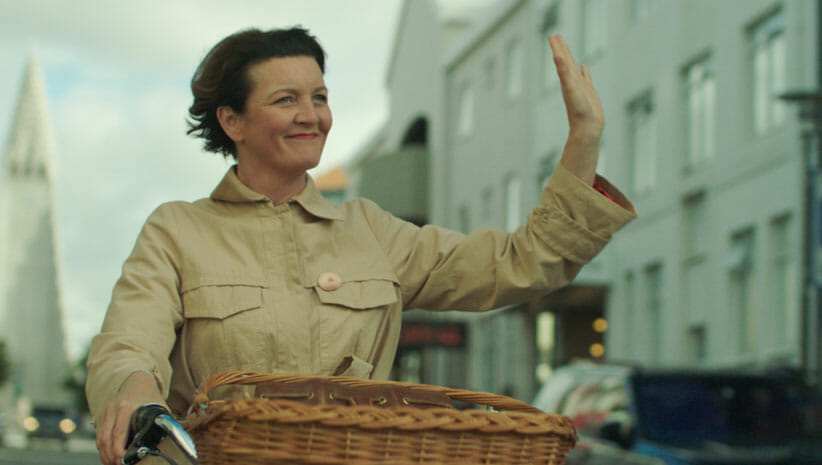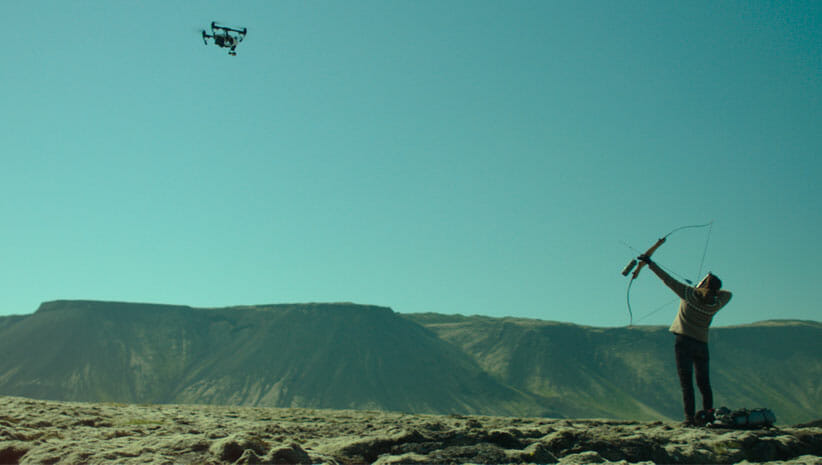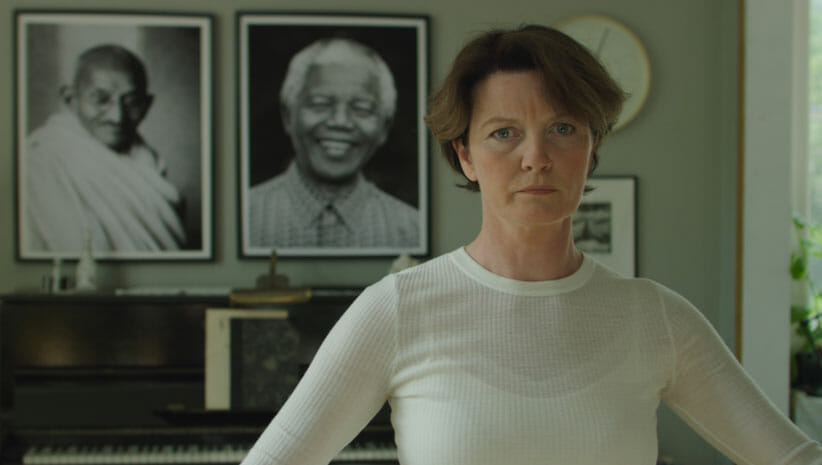
Halldóra Geirharðsdóttir in WOMAN AT WAR, a Magnolia Pictures release. Photo courtesy of Magnolia Pictures.
Woman at War’s Heroine Wants to Save the Environment
Woman at War opens with a shot of our heroine Halla (played by Halldóra Geirhasdóttir) in a scenic Icelandic field, about to shoot an arrow in a quest that we learn more about throughout the film.
A modern-day Artemis, Halla is seeking to further a national—and international conversation—around environmental issues through her acts of industrial espionage. She’s an environmental warrior with a day job as a choir conductor. Halla puts the strengths of her convictions on the line in her actions. Her desire to make a positive difference is the impetus for how she strings her bow.

Halldóra Geirharðsdóttir in WOMAN AT WAR, a Magnolia Pictures release. Photo courtesy of Magnolia Pictures.
Halla’s desire for integrity in the outer world is mirrored by her relationship and conversations with her twin sister, professional yoga instructor Ása (also played by Halldóra Geirhasdóttir). Ása announces her plans to spend two years meditating at an ashram in India, when Halla receives the letter naming her long-awaited acceptance to adopt a girl from the Ukraine. The letter announcing impending motherhood may complicate Halla’s ongoing escalation of her side hustle saving the Icelandic landscape. This provides the film’s central conflict. It’s a challenge that everyone must navigate.
Meaningful Moments in Woman at War
There are many meaningful moments in this cleverly told story by director, writer, and producer Benedikt Erlingsson. Halldóra offers a humorous, sympathetic, and at the same time poignant portrayal of the sisters. The hapless Spanish-speaking tourist Juan Camillo who often ends up just in the wrong place throughout the story, raining Spanish curse words at the authorities. Cinematography that highlights the beauty of the Icelandic scenery so that we all as viewers want to protect it. Unexpected laugh-out-loud moments delivered by a farmer Halla asks for help. And in one of the best features of the film, musical and song accompaniment provided by a three-piece band and a trio of Ukranian folk singers who appear in the frame as both chorus and curious observers.
The twists and turns in Woman at War offer a discourse on the dynamic between our inner peace and our outer principles. It questions how can we live in a world that asks us to compromise? And, as the film’s ending illustrates, how we can maintain hope as we venture forward into the unknown?

Halldóra Geirharðsdóttir in WOMAN AT WAR, a Magnolia Pictures release. Photo courtesy of Magnolia Pictures.
See Woman at War
While watching Woman at War, you’ll be riveted to the screen and the story. It’s the kind of film whose impact lingers long after the credits have completed. Woman at War is captivating. See it on a big screen if you can. But see it with friends and share discussions over drinks after watching.
See Woman at War at the Laemmle theaters in Los Angeles.
Learn more about Woman at War.
Felicia Tomasko has spent more of her life practicing Yoga and Ayurveda than not. She first became introduced to the teachings through the writings of the Transcendentalists, through meditation, and using asana to cross-train for her practice of cross-country running. Between beginning her commitment to Yoga and Ayurveda and today, she earned degrees in environmental biology and anthropology and nursing, and certifications in the practice and teaching of yoga, yoga therapy, and Ayurveda while working in fields including cognitive neuroscience and plant biochemistry. Her commitment to writing is at least as long as her commitment to yoga. Working on everything related to the written word from newspapers to magazines to websites to books, Felicia has been writing and editing professionally since college. In order to feel like a teenager again, Felicia has pulled out her running shoes for regular interval sessions throughout Southern California. Since the very first issue of LA YOGA, Felicia has been part of the team and the growth and development of the Bliss Network.
